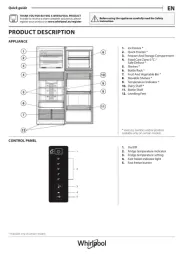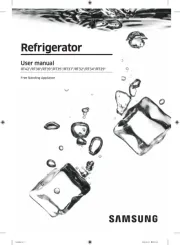Whirlpool WRB322DMBM Handleiding
Whirlpool
Koel-vries combinaties
WRB322DMBM
Bekijk gratis de handleiding van Whirlpool WRB322DMBM (35 pagina’s), behorend tot de categorie Koel-vries combinaties. Deze gids werd als nuttig beoordeeld door 52 mensen en kreeg gemiddeld 4.4 sterren uit 26.5 reviews. Heb je een vraag over Whirlpool WRB322DMBM of wil je andere gebruikers van dit product iets vragen? Stel een vraag
Pagina 1/35

W11479841C
BOTTOM-MOUNT REFRIGERATOR OWNER'S
MANUAL
MANUEL D’UTILISATION DU RÉFRIGÉRATEUR AVEC
CONGÉLATEUR EN BAS
Table of Contents/Table des matières
MAINTENANCE AND CARE .............................................. 3
Cleaning ......................................................................3
Changing the LED Module ............................................... 3
Water Filtration System ................................................... 3
Vacation and Moving Care ............................................... 4
INSTALLATION INSTRUCTIONS ........................................4
Unpack the Refrigerator .................................................. 4
Electrical Requirements .................................................. 5
Location Requirements ................................................... 5
Water Supply Requirements............................................. 6
Connect the Water Supply ............................................... 6
REFRIGERATOR FEATURES.............................................7
Crisper Humidity Control .................................................7
DOOR AND HANDLE INSTRUCTIONS ................................ 7
Refrigerator Doors and Drawer ......................................... 7
Remove and Replace Door Handles ..................................8
Remove Doors and Hinges ..............................................9
Reverse Doors (optional)............................................... 11
Replace Doors and Hinges ............................................ 12
Remove and Replace Freezer Drawer .............................. 14
PERFORMANCE DATA SHEET ........................................ 16
Performance Data Sheet ............................................... 16
SÉCURITÉ DU RÉFRIGÉRATEUR . ................................... 18
Sécurité du réfrigérateur................................................ 18
ENTRETIEN ET RÉPARATION ......................................... 19
Nettoyage .................................................................. 19
Remplacer le module à DEL ........................................... 20
Système de filtration de l’eau.......................................... 20
Précautions à prendre avant les vacances ou le
déménagement ........................................................... 21
INSTRUCTIONS D’INSTALLATION ................................... 21
Déballage du réfrigérateur ............................................. 21
Spécifications électriques .............................................. 22
Exigences d’emplacement ............................................. 22
Spécifications de l’alimentation en eau ............................. 23
Raccordement à la canalisation d’eau .............................. 23
CARACTÉRISTIQUES DU RÉFRIGÉRATEUR..................... 25
Réglage de l’humidité dans le tiroir à légumes .................... 25
INSTRUCTIONS POUR LA PORTE ET LA POIGNÉE ............ 25
Portes et tiroir du réfrigérateur ........................................ 25
Consulter la section Retrait et réinstallation des poignées de
porte ......................................................................... 25
Démontage des portes et charnières................................ 27
Inversion des portes (facultatif) ....................................... 29
Réinstallation des portes et charnières ............................. 30
Retrait et réinstallation du tiroir de congélation ................... 32
FICHE DE DONNÉES DE PERFORMANCE ........................ 34
Fiche de données de performance................................... 34
REFRIGERATOR SAFETY......... ....... ............ ..................... 2
Refrigerator Safety ...................................................... 2

2
Your safety and the safety of others are very important.
We have provided many important safety messages in this manual and on your appliance. Always read and obey all safety
messages.
This is the safety alert symbol.
This symbol alerts you to potential hazards that can kill or hurt you and others.
All safety messages will follow the safety alert symbol and either the word “DANGER” or “WARNING.” These
words mean:
DANGER You can be killed or seriously injured if you don't
immediately follow instructions.
WARNING You can be killed or seriously injured if you don’t follow
instructions.
All safety messages will tell you what the potential hazard is, tell you how to reduce the chance of injury, and tell you what can
happen if the instructions are not followed.
IMPORTANT SAFETY INSTRUCTIONS
WARNING: To reduce the risk of fire, electric shock, or injury to persons when using your appliance, follow basic precautions,
including the following:
�Children should be supervised to ensure that they do not
play with the appliance.
�This appliance is not intended for use by persons (including
children) with reduced physical, sensory, or mental
capabilities, or lack of experience and knowledge, unless
they have been given supervision or instruction concerning
use of the appliance by a person responsible for their
safety.
�Do not use an extension cord.
�If power supply cord is damaged, it must be replaced by the
manufacturer, its service agent, or a similarly qualified
person in order to avoid a hazard.
�Connect to potable water supply only.
�This appliance is intended to be used in household and
similar applications such as: staff kitchen areas in shops,
offices, and other working environments; farm houses and
by clients in hotels, motels, and other residential-type
environments; bed and breakfast-type environments; and
catering and similar non-retail applications.
�Do not store explosive substances such as aerosol cans
with a flammable propellant in this appliance.
�Do not use replacement parts that have not been
recommended by the manufacturer (e.g., parts made at
home using a 3D printer).
�Keep ventilation openings, in the appliance enclosure or in
the built-in structure, clear of obstruction.
�Do not use mechanical devices or other means to
accelerate the defrosting process, other than those
recommended by the manufacturer.
�Do not damage the refrigerant circuit.
�Do not use electrical appliances inside the food storage
compartments of the appliance, unless they are of the type
recommended by the manufacturer.
�Ice make kit can be added to some models. See serial tag
inside the food compartment of appliance for ice maker kit
model information.
�A qualified service technician must install the water line and
ice maker. See installation instructions supplied with ice
maker kit for complete details.
SAVE THESE INSTRUCTIONS
Proper Disposal of Your Old Refrigerator
WARNING: Risk of child entrapment. Before you throw away
your old refrigerator or freezer:
�Take off the doors.
�Leave the shelves in place so that children may not easily
climb inside.
WARNING
Suffocation Hazard
Remove doors or lid from your old appliance.
Failure to do so can result in death or brain damage.
IMPORTANT: Child entrapment and suffocation
are not problems of the past. Junked or
abandoned refrigerators are still dangerous,
even if they will sit for “just a few days.” If you are
getting rid of your old refrigerator, please follow
these instructions to help prevent accidents.
Important information to know about
disposal of refrigerants:
Dispose of refrigerator in accordance with
federal and local regulations. Refrigerants must
be evacuated by a licensed, EPA-certified
refrigerant technician in accordance with
established procedures.
REFRIGERATOR SAFETY

3
MAINTENANCE AND CARE
Cleaning
WARNING
Explosion Hazard
Risk of Fire or Explosion.
Flammable Refrigerant Used.
Do Not Use Mechanical Devices to Defrost Refrigerator.
Do Not Puncture Refrigerant Tubing.
Both the refrigerator and freezer sections defrost automatically.
However, clean both sections about once a month to avoid odor
buildup. Wipe up spills immediately.
IMPORTANT:
�Because air circulates between both sections, any odors
formed in one section will transfer to the other. You must
thoroughly clean both sections to eliminate odors. To avoid
odor transfer and drying out of food, wrap or cover foods
tightly.
�For stainless steel models, stainless steel is corrosion-
resistant and not corrosion-proof. To help avoid corrosion of
your stainless steel, keep your surfaces clean by using the
following cleaning instructions.
To Clean Your Refrigerator:
NOTE: Do not use abrasive or harsh cleaners such as window
sprays, scouring cleansers, flammable fluids, muriatic acid,
cleaning waxes, concentrated detergents, bleaches, or cleansers
containing petroleum products on exterior surfaces (doors and
cabinet), plastic parts, interior, and door liners or gaskets. Do not
use paper towels, scouring pads, or other harsh cleaning tools.
1. Unplug refrigerator or disconnect power.
2. Hand-wash, rinse, and dry removable parts and interior
surfaces thoroughly. Use a clean sponge or soft cloth and a
mild detergent in warm water.
3. Clean the exterior surfaces.
Painted metal: Wash painted metal exteriors with a clean,
soft cloth or sponge and a mild detergent in warm water. Rinse
surfaces with clean, warm water and dry immediately to avoid
water spots.
Stainless steel: Wash stainless steel surfaces with a clean,
soft cloth or sponge and a mild detergent in warm water. Rinse
surfaces with clean, warm water and dry immediately to avoid
water spots.
NOTE: When cleaning stainless steel, always wipe with the
grain to avoid cross-grain scratching.
WARNING
Explosion Hazard
Risk of Fire or Explosion due to Puncture of Refrigerant
Tubing;
Follow Handling Instructions Carefully.
Flammable Refrigerant Used.
4. There is no need for routine condenser cleaning in normal
home operating environments. If the environment is
particularly greasy or dusty, or there is a significant pet traffic
in the home, the condenser should be cleaned every 2 to 3
months to ensure maximum efficiency.
If you need to clean the condenser:
�Pull refrigerator out away from the wall. See “Unpack the
Refrigerator.”
�Remove the base grille.
�Vacuum coils when they are dusty or dirty.
�Replace the base grille when finished.
�Roll refrigerator back into place. Make sure to leave 1"
(2.5 cm) between the cabinet back and the wall.
�Check to see that the refrigerator is level.
5. Plug in refrigerator or reconnect power.
Changing the LED Module
IMPORTANT: The lights in both the refrigerator and freezer
compartments use LED technology that do not need to be
replaced.
If an LED module(s) do not illuminate when the refrigerator and/or
freezer door is opened, call for assistance or service. See "Quick
Start Guide" for contact information.
Water Filtration System
The water filter is located in the upper right-hand corner of the
refrigerator compartment.
Do not use with water that is microbiologically unsafe or of
unknown quality without adequate disinfection before or after the
system. Systems certified for cyst reduction may be used on
disinfected waters that may contain filterable cysts.
IMPORTANT: The disposable water filter should be replaced at
least every 6 months. If the water flow to the water dispenser or
ice maker decreases noticeably before 6 months have passed,
replace the water filter more often.
Product specificaties
| Merk: | Whirlpool |
| Categorie: | Koel-vries combinaties |
| Model: | WRB322DMBM |
Heb je hulp nodig?
Als je hulp nodig hebt met Whirlpool WRB322DMBM stel dan hieronder een vraag en andere gebruikers zullen je antwoorden
Handleiding Koel-vries combinaties Whirlpool

4 Oktober 2022

4 Oktober 2022

4 Oktober 2022

4 Oktober 2022

4 Oktober 2022

4 Oktober 2022

4 Oktober 2022

4 Oktober 2022

4 Oktober 2022

4 Oktober 2022
Handleiding Koel-vries combinaties
- Zanker
- PKM
- Kenmore
- Junker
- Samsung
- Thermador
- Lamona
- Montpellier
- Maytag
- Ignis
- Pelgrim
- Respekta
- Viking
- New Pol
- Inventor
Nieuwste handleidingen voor Koel-vries combinaties

4 Oktober 2022

4 Oktober 2022

4 Oktober 2022

4 Oktober 2022

4 Oktober 2022

4 Oktober 2022

4 Oktober 2022

4 Oktober 2022

4 Oktober 2022

4 Oktober 2022